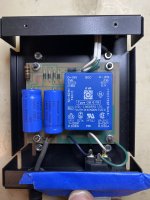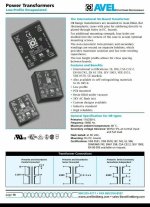It's uncommon but they can. As already covered, cheap core material / construction, magnetically run too 'hard', shorted 'mechanical turn' etc etc.
But I hear you, something seems not right. I've had some pretty bizarre transformer related problems to solve on the bench.
But I hear you, something seems not right. I've had some pretty bizarre transformer related problems to solve on the bench.
That may be with 1 transformer (the special 40 VA one) but it is also with the 250VA one. If a third one behaves the same other things are happening there.
I deal with issues and think this is is such a case where the cause is not easily detected. In other words: a nice challenge!
I deal with issues and think this is is such a case where the cause is not easily detected. In other words: a nice challenge!
Last edited:
I had a look at the net, it seems energy limiting transformers have a core gap, between primary and secondary windings, so yes they can inherently have high idle current.
So they will run hotter than normal.
And a bigger unit will tend to have poor regulation, it must be putting out a higher secondary voltage at idle compared to the old, smaller unit.
That is why I said the transformer choice is abnormal, for whatever reason, it may be a legal requirement in that market or country.
So they will run hotter than normal.
And a bigger unit will tend to have poor regulation, it must be putting out a higher secondary voltage at idle compared to the old, smaller unit.
That is why I said the transformer choice is abnormal, for whatever reason, it may be a legal requirement in that market or country.
Never have seen "energy limiting" transformers and this one does not seem to limit energy either 🙂 I looked it up and "energy limiting transformers" seem to be a US affair as there are no fuses or breakers needed (cheap). Yup that is very verboten here and thankfully so. The energy limiting = transformer stays unaffected by momentary short circuit and continued short circuit of secondary will cause primary winding to open in 1 to 2 minutes without creating a fire hazard.
The 250VA is a normal EI type AFAIK so things should be back to normal I would assume (without load). Still that one also gets hot.
The 250VA is a normal EI type AFAIK so things should be back to normal I would assume (without load). Still that one also gets hot.
Last edited:
Another description is current limiting transformer, earlier in this thread.
Peculiar...an odd problem.
Peculiar...an odd problem.
Let's add to all this. Below is a picture of a Threshold Universal power supply for preamps. It's been plugged in for 24 hours, no preamp is connected but the rectifier, 2 resistors and filter caps are still in circuit and it IS NOT running hot. It's rated at 3 VA. Is it just a better quality transformer?
Eric M.
Eric M.
Attachments
If it limits current that still does not explain the heat when unloaded...I think there is high mains harmonics/distortion there or high DC component on the mains voltage. OP mentions the transformers also to hum without load which also indicates trouble.
Eric M, that is a 6VA transformer. The mains does not even feel if it is connected or not.
Eric M, that is a 6VA transformer. The mains does not even feel if it is connected or not.
Last edited:
The best and quickest way to modernize that kind of small electrical 24V installations is to replace the power supply transformer with a 24V DC switching power supply. Cheaper and more readily available than a quality transformer, does have the required internal overcurrent/short circuit protection, idle power is less than 1W, and the output is regulated so most weird issues due to mains supply perturbations are gone. Just check that the loads are rated for DC operation (almost all are).
Yeah, switching all the relays and timer to DC is more than I want to do! I'll change to the 3-way switch at the main before doing that.
The 250VA got hot and hummed without any load isn't it? Do you have other devices with transformers in your home that exhibit the same behavior? Lighting that does not live very long either? Does it heat up with covers removed/open as well (casing seems airtight so not OK by design)?
Last edited:
Yes, I agree. The original transformer is nothing special. These are extremely common and used in dosmetic and commercial HVAC systems for the control circuit consisting of a thermostat and contactor, etc.Never have seen "energy limiting" transformers and this one does not seem to limit energy either
And "energy limiting" or not, no transformer should get hot if there is truly "NO load" on the secondary.
It was joking as these are special because they apparently can do without fuses or circuit breakers (intrinsically bad practice) as current is limited by construction. No fire hazard but what about persons!?
Not that I know of other than the 2 transformers mentioned that do get hot and that post above with the Threshold preamp power supply that does not get hot. We have all sorts of wall art type transformers for iPhones, networking, etc. that seem to do fine.The 250VA got hot and hummed without any load isn't it? Do you have other devices with transformers in your home that exhibit the same behavior? Lighting that does not live very long either? Does it heat up with covers removed/open as well (casing seems airtight so not OK by design)?
Eric M.
That other ones you mention (except the Threshold) are not transformers but SMPS.
The ones with steel core and copper wires are meant.
The ones with steel core and copper wires are meant.
The best course of action is of course to repair the fault and have the original circuit working again. But if this will be difficult, switching to DC is still a option. According to the picture, the timer is rated for both DC and AC. In theory, the AC relays should be exchanged, or a resistor should be connected in series to drop the voltage (about 20%, usually). In practice, quality AC relays tolerate a +/-20% deviation to the solenoid voltage to compensate for mains fluctuations. This means, they may accept both AC and DC. Small AC relays may still have troubles when DC is applied, due to residual magnetism that may impede a quick release of the mobile contact - the fix is to stick a piece of kapton tape on the pole, to create a gap in the magnetic circuit. This is not the case for bigger power relays, they require substantial force to actuate and are less sensitive to residual magnetism.Yeah, switching all the relays and timer to DC is more than I want to do! I'll change to the 3-way switch at the main before doing that.
An alternate would be as above, using open chassis mount contactors with DC coils.
Or simply change to proximity switches (complex) or trash the circuit, use 12V parts throughout, and a thermal fuse for motor instead of timer.
The switches are mechanical, so 12V will not be an issue.
A standard 3A / 240V AC contact rated relay will do fine, I think it will take the motor load quite well.
DC supply can be SMPS wall wart, or board mounted SMPS.
All the circuit seems to do is ensure all the switches for safety are closed, and the limit switches for travel are wired to do just that, stop it moving when travel end is reached.
That is the peculiar part, what is taking so much current in the current setup?
Or simply change to proximity switches (complex) or trash the circuit, use 12V parts throughout, and a thermal fuse for motor instead of timer.
The switches are mechanical, so 12V will not be an issue.
A standard 3A / 240V AC contact rated relay will do fine, I think it will take the motor load quite well.
DC supply can be SMPS wall wart, or board mounted SMPS.
All the circuit seems to do is ensure all the switches for safety are closed, and the limit switches for travel are wired to do just that, stop it moving when travel end is reached.
That is the peculiar part, what is taking so much current in the current setup?
- Home
- General Interest
- Everything Else
- Need Some Advice Regarding a Handicap Lift, Odd Transformer Issue

